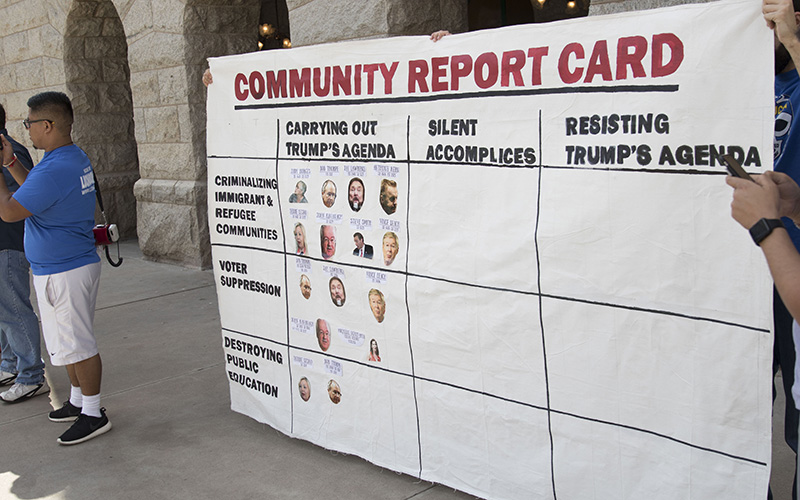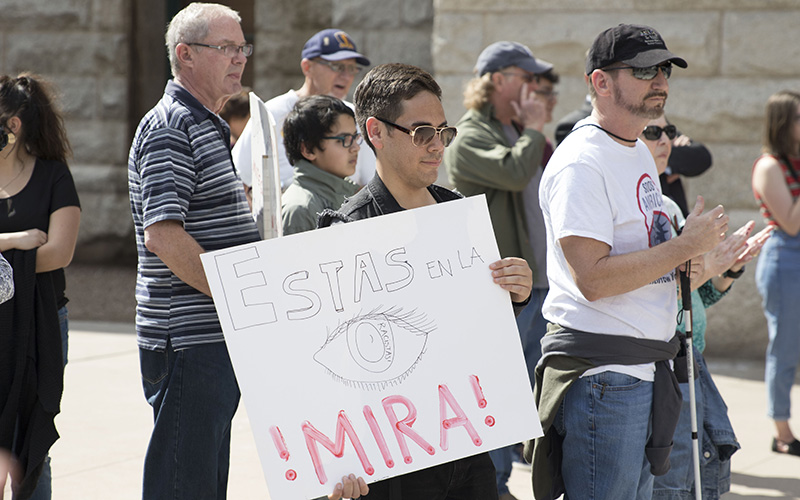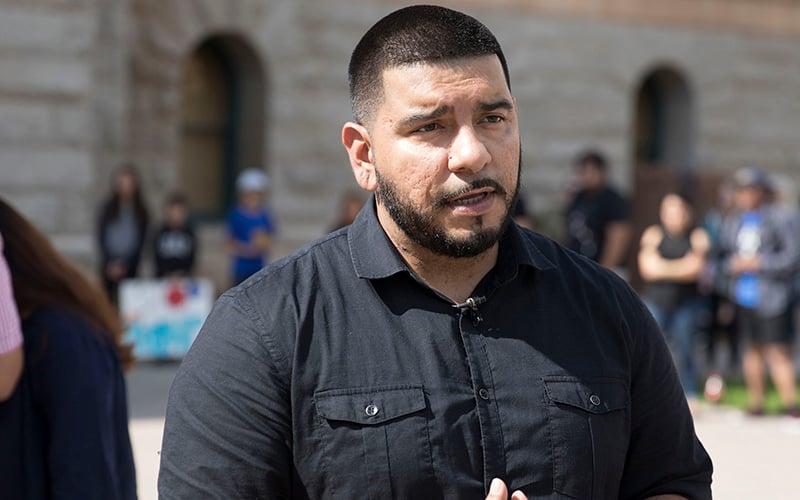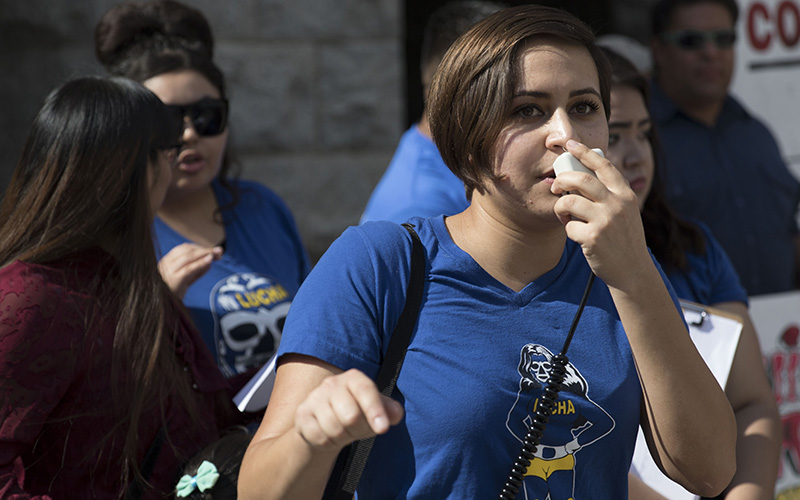
LUCHA activists hold up a “community report card,” grading Arizona legislators on their performance since the election on issues involving immigration, education and water rights. (Photo by Josh Orcutt/Cronkite News)
PHOENIX — Wearing matching blue shirts in front of the Arizona state Capitol on a recent afternoon, members of the immigration advocacy group LUCHA held up a large “report card” grading Arizona lawmakers on how they have done since the general election in November.
“Back up, we want freedom. All these racist politicians, we don’t need ‘em,” the demonstrators chanted, hoping their words of disapproval reached the ears of legislators working within the depths of the state house and senate buildings.
LUCHA and other groups hold rallies similar to this on a regular basis, most often using social media to coordinate the events and spread the word encouraging others to join the cause.
Coupled with the fiery, often divisive rhetoric dominant in today’s political discourse, social media has become a major outlet for groups on all sides of political issues to organize rallies, protests, counter-protests, as well as promote their messages and recruit like-minded people to join their movements.
Whether opponents of executive orders from President Donald Trump or proponents of stronger immigration who want a border wall, social media is one of the most powerful messengers.

Demonstrators display signs and gather in front of the Arizona state capitol to protest local lawmakers who members of LUCHA call “Trumpistas,” or little Trumps, for carrying out what LUCHA says are President Trump’s “divisive and hateful” policies. (Photo by Josh Orcutt/Cronkite News)
“Absolutely, right now everyone’s using it,” said Terry Kurtzer, director of the Valley-based social media firm Social Media Phoenix when asked if groups are upping their use of social media as a rallying tool.
Recently immigration advocacy groups such as LUCHA and Puente have proliferated their social media presence as a means to further advance their pro-immigrant messages to people on a grander scale.
“Every time there’s something extremely huge happening, like an action or something related to any kind of work Puente has done on the ground, it’s amplified online,” said Lucy Sandoval, communications director for Puente. “So, this is an amplifying tool for direct action.”
Immigration and Customs Enforcement (ICE) agents deported Mesa mom and undocumented immigrant Guadalupe Garcia de Rayos when she showed up for a routine check-in with immigration officials.
When Puente got word of her impending deportation, the group used social media to help gather protesters outside of the ICE office. They used the Facebook Live feature to live-broadcast the protest and allow users from anywhere to witness the event.
“Guadalupe, while she was in the van, all of that was happening and it was live,” Sandoval said, referring to protesters who were blocking the ICE van that was believed to be transporting Garcia de Rayos.
“We were telling people in the live stream to come out to ICE, and people were showing up in numbers. It was just another way to bring more people out,” Sandoval said.
The demonstration made national headlines and news after it spread social media sites.
“It’s just become another vehicle for us to be able to get our message out there and communicate with a vast variety of people in a short amount of time,” said Tomas Robles, director of LUCHA.
Robles said his group has been active on social media since 2010, but has expanded its presence on sites like Facebook and Twitter as an attempt to allow people to follow the group in a more directly engaging way.

LUCHA director Tomas Robles was part of the demonstrations at the capitol last week, and his group is beginning to host weekly gatherings outside the capitol every Tuesday at 4:20 p.m. (Photo by Josh Orcutt/Cronkite News)
“Sometimes when we speak with media they don’t necessarily put out the full story,” Robles said. “It also allows us to, when we have a connection with the folks that follow us, to know what is happening at the Capitol, why they should care and personal stories.”
LUCHA approached Arizona legislators recently to give them “eviction notices for grievances about the legislators’ recent performances regarding voting rights, immigration and education.
The organization used a Facebook page to promote the report-card rally and eviction notice events, also creating a forum for people to discuss the event and its message.
The goal of groups on either side of the political spectrum is to engage with social media-users who have not directly been involved with advocacy groups, but have followed the movements through Twitter, Facebook or other platforms.
Providing a path for people to become involved in campaigns is crucial for organizations to gain traction.
“Part of it is doing stuff like this so we can get pictures that can be posted out on social media,” Nicole Hale, a LUCHA organizer, said as her counterparts yelled the chants outside of the Arizona state senate building.
“There’s a lot of people sitting at home that interact with social media and want to do something, but they don’t know what to do,” Hale said. “Using that as a platform to reach them, to get them out here, is totally the goal.”
Other groups such as Stand With Arizona have amassed huge followings on Facebook. The SWA page has nearly 800,000 likes, and is used to push tighter immigration controls and conservative messages to its followers.
A “March 4 Trump” rally at the state Capitol scheduled for March 4 has been largely planned through a Facebook event page in which people can easily invite their friends and spread the word with the click of a button.

Immigration activist Nicole Hale talks in the megaphone, her voice roaring over the noise of the crowd in front of her. Hale says events like this demonstration are important to engage people into the LUCHA movement via social media. (Photo by Josh Orcutt/Cronkite News)
“We’ve been getting the message out, advertising, talking to people,” said Barb Heller, an organizer for the event. “(Facebook) is a common tool used now.”
Heller said the goal of her event is to unify people who support of the president’s proposals and executive actions on immigration. And despite opponents countering the event over social media and saying they plan to “come after us,” said Heller, she’s optimistic the march will unite people.
“We try and bring to the table a rounded number of speakers of all walks of life,” Heller said, referring to weekend’s rally at the state capitol. “We need to unify. We’ve been pulled apart, and it doesn’t matter who is president, if we don’t unify, we’re going to destroy ourselves.”
In the wake of nationwide protests after the President Trump’s inauguration, as well his divisive immigration policies, Heller said she hopes this event will be a positive inspire peaceful action and motivate “keyboard warriors,” who eschew in-person demonstrations altogether.
Kurtzer, who teaches classes on how businesses can use social media to draw in prospects and customers, compares the use of political advocacy through social media to businesses promoting their brand. However, he cautions in some cases social media when used advocacy groups can become an echo chamber.
“It promotes ‘groupthink.’ It’s effective at getting the message out … but it’s not changing anyone’s mind,” Kurtzer said. “They’re preaching to their own choir.” An added element to today’s social media environment is President Trump’s use of Twitter as a platform to voice his opinions and respond to criticism in a direct way.
“One thing he’s made great again is Twitter,” Kurtzer said.
Puente uses Trump’s often combative, sometimes controversial tweets as a sort of rallying-cry, particularly tweets relating to his hardline immigration policy and border wall.
“He uses his own, personal Twitter to post comments about his presidency, which is really unprofessional,” Sandoval said. “But we use that as a tool to kind of target people as well, and to figure out our own strategy.”
Sandoval cautioned that social media can take away from the on-ground work activists are doing, and because people can follow advocacy groups remotely, they don’t always feel the need to participate in live events, including voting, as well as demonstrations.
Members of groups, conservative, liberal, or in-between, all agree that showing up at events, rallies or protests supersedes social media advocacy.
“Sometimes people are disconnected from actually coming to the event, and think that because it is live-streamed, that’s them taking part,” Sandoval said. “There’s no time to wait, and it’s an urgent moment to not be at home, watching a live stream. Change comes in the street in direct action, through people and through organizing.”